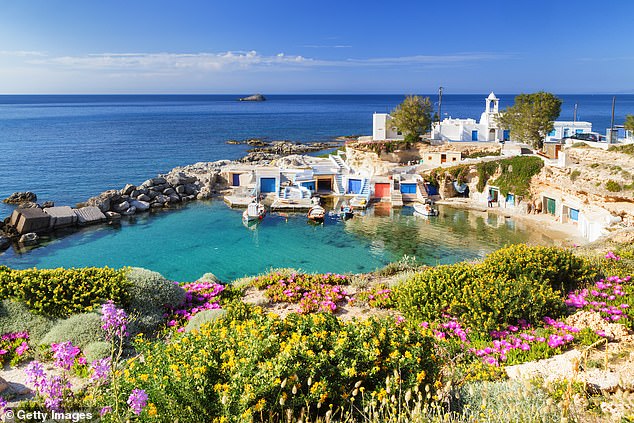The armless figure, with its bare torso and inscrutable gaze, looks familiar as it appears on a mud-covered dirt road.
Closer inspection reveals that yes, it is indeed Venus de Milo, the poster girl for ancient Hellenic sculpture and star of millions of rounds of pub picture contests.
But what is she doing here, alone, on a windy hillside on the Greek island of Milos? Instead of at the Louvre in France?
George, our ‘We Bike Milos’ guide, is quick to point out in a baritone voice that what we’re actually seeing is a replica.
This double body marks the spot in Melos (now Milos) where, one afternoon in April 1820, a farmer discovered the original marble masterpiece, crafted sometime between 150 and 125 BC, which he initially erected outside his house .
Catch of the Day: Angela Epstein and her husband exploring the island of Milos, Greece
Do the locals want Venus to return to the island? my husband Martin wonders. “Listen,” George shrugs with an easy smile, “these aren’t the Elgin Marbles.” (The subject of the controversy between Great Britain and Greece).
Our exchange with the affable George is a snapshot into Milian’s psyche. And it might explain why more and more people are visiting Milo.
Then again, its blue seas, pristine beaches, historic architecture, geological wonders and picturesque whitewashed fishing villages (with doors and window frames in eye-catching bright colors) where seafood is caught daily, might also have something to do with it.

Angela reveals that Plaka Village, the former hilltop capital, has a “360-degree view of the sea and neighboring islands.”

Sarakiniko, with its white rock formations, is the most “amazing” beach on the island, says Angela, adding that it looks like “a lunar landscape.”
There are no direct flights to Milos from the UK, although it has a domestic airport with flights from Athens, so getting here requires effort. But that is well rewarded.
Our trip begins with a flight to neighboring Santorini and then a two-hour ferry to Milos.
A car is important if you want to get around, as although the island only measures 12 miles from east to west and eight from north to south, you definitely won’t be able to rely on finding a taxi.
The ship docks in the port city of Adamantas, one of the largest natural harbors in the Mediterranean and the commercial center of the island.

Angela takes a boat to Kleftiko, a sprawling chain of rocky coves and sea caves that can only be reached by boat
The city is home to around 1,200 inhabitants, so “center” goes a little further. (There are only 5,000 people on the entire island).
From there, it’s a 15-minute drive to Noma, an adults-only boutique hotel that, with its high ceilings, earth tones, and wood and clay furnishings, seems to blend into the landscape.
Milos is mountainous, which is why an electric bike is such an easy and efficient way to see the island.
The roads are quiet and nowhere is far – it takes no more than 40 minutes to get anywhere. And there is a lot to see.

A room at the adults-only Noma hotel, the base of Angela’s trip, which “seems to blend into the landscape”

Fresh seafood is caught daily on the island, reveals Angela
Our favorite places include Plaka, the ancient hilltop capital, where we strolled through narrow, cobblestone alleys covered in bougainvillea and lined with whitewashed houses.
Here we find the church of Panagia Korfiatissa, built in 1820 with materials brought from the abandoned churches of the old town.
Given Plaka’s altitude (about 254 meters), the highlight is the 360-degree view of the sea and neighboring islands.
Another place of interest, especially because it seems so anomalous, is located in the town of Tripiti, where we find catacombs (ancient underground Christian cemeteries used in Roman times). They were discovered in 1844 and it is estimated that they were built at the end of the 1st century AD
Milos benefits from the prevailing north wind, what our bike tour guide George calls the “Aegean air conditioning”, which cools us in the heat as we cycle along.
The island has more than 70 beaches. The most striking is Sarakiniko, a white rock lunar landscape.
Here we climb like the first astronauts over volcanic rock formations, which undulate into the shallow, refreshing aquamarine waters.
However, one of the most distinctive sites in Milos is Kleftiko, an extensive chain of rocky coves and sea caves that can only be reached by boat.
We joined a tour, anchored so we could dive into the cool, crystal clear sea to duck and dive through large arch-shaped rock formations.
Like much of this island, Kleftiko is a wonderful place and for us it is a true Greek discovery.
Unlike the real Venus de Milo, we have every intention of returning.


